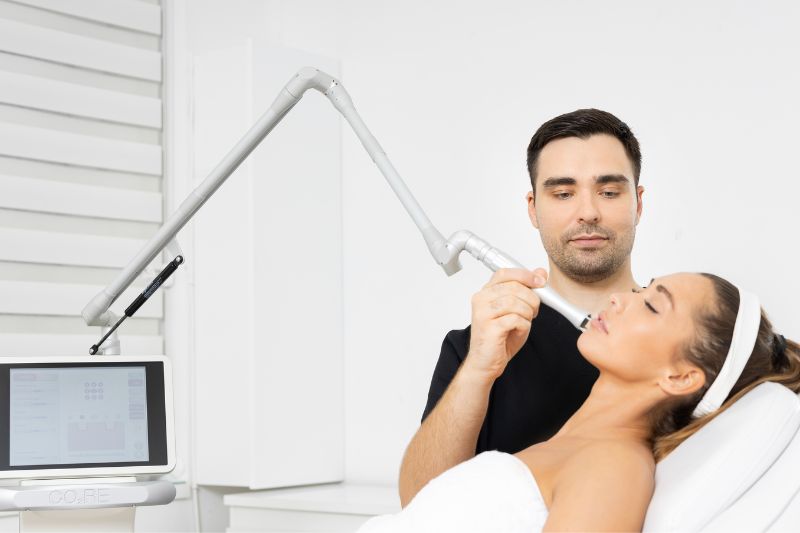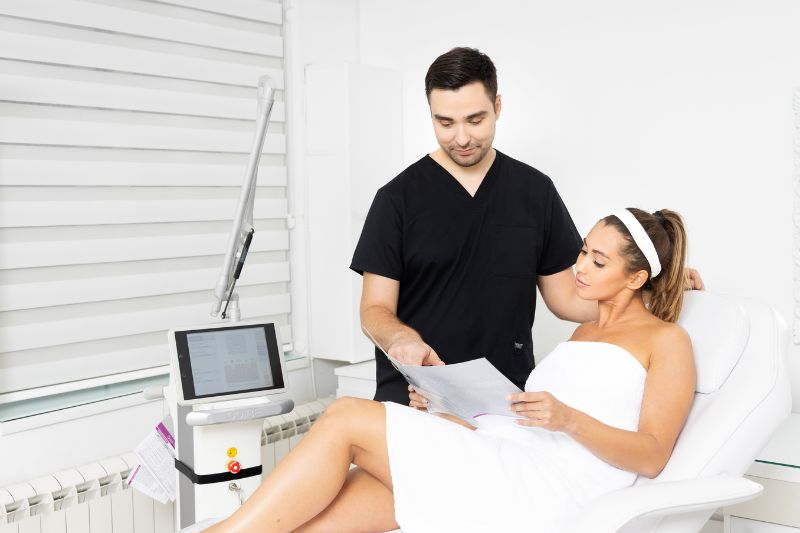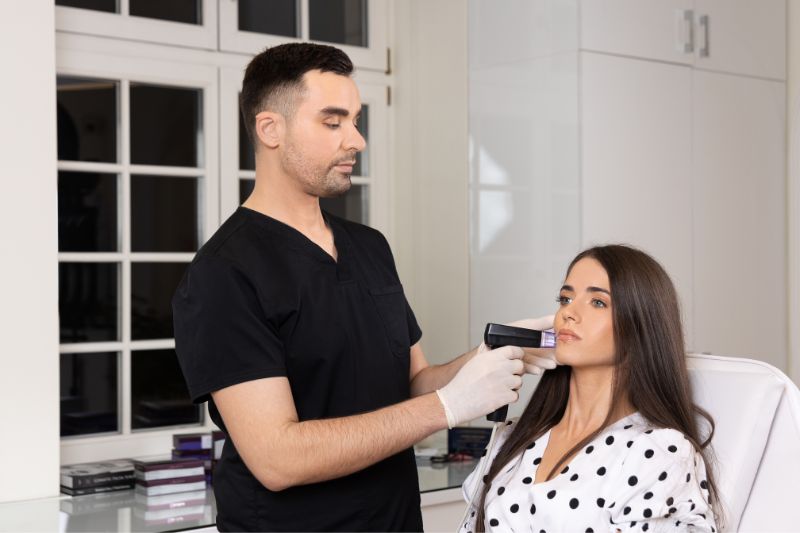Laser scar removal is the most effective method when it is necessary to remove scars from the skin. It is a painless, safe, and non-invasive procedure. By using CO2 and non-ablative lasers, acne scars, keloids, postoperative scars, and stretch marks can be significantly reduced and almost completely disappear. These lasers stimulate collagen production and promote skin remodeling, resulting in a noticeable improvement in the appearance of scars.

What is laser scar removal?
Regardless of the type of scars, their presence can have a negative impact on self-confidence and aesthetic appearance, particularly when they are located on the face. Removing scars can be a time-consuming process that requires patience. While surgical procedures are available for more challenging scars, laser scar removal is considered a gold standard and highly effective method. It is a non-operative, minimally invasive solution that gradually reduces or softens scars.
types of scars
- Acne scars: These scars develop as a result of the inflammatory process accompanying acne and pimples. Improper acne treatment can lead to the formation of scars that remain on the skin permanently. They are more common in younger individuals but can occur at any age.
- Atrophic scars: These scars result from changes in the deeper layers of the skin. Among them are stretch marks, which can be categorized as either young (red) or old (white). Both types pose significant aesthetic concerns and should be addressed in a timely manner.
- Hypertrophic scars: These scars often form at the site of cuts or injuries. They are typically red to purple in color, raised above the skin surface, and may cause discomfort or pain.
- Keloid scars: Keloid scars are characterized by their thickened, painful, and red appearance. They extend beyond the boundaries of the original wound and commonly occur on the neck, décolletage, and behind the ears. Keloid scars require treatment as they do not naturally diminish over time.
Laser scar removal is an effective approach for addressing these various types of scars, helping to reduce their visibility and improve the overall appearance of the skin.
How does laser scar removal work?
Lasers hold a significant position in the fields of dermatology, aesthetic medicine, and anti-aging treatments. Continuous advancements in laser technology allow for reliable treatment of various indications and conditions. Laser therapy is particularly effective in addressing rosacea, hyperpigmentation, redness, enlarged capillaries, and melasma.
Laser scar treatment is a minimally invasive and dependable method:
- The laser facilitates the recovery of damaged cells, accelerates the healing process of scar tissue, and promotes skin regeneration, resulting in gradual fading and disappearance of the scar.
- By removing the superficial layer of the skin, the light from the laser penetrates the dermis, stimulating the production of new collagen.
- The skin’s structure is restored, and the scars are filled with new, youthful skin. Consequently, lasers offer an ideal solution for eliminating various imperfections such as hyperpigmentation, spots, enlarged pores, and capillaries.
The choice of laser and adjustment of parameters (including wavelength, focus of radiation, and laser pulses) depend on the type, appearance, and condition of the scar. It is essential for patients to know that laser scar removal treatments are comfortable, brief in duration, and provide long-term results.
Who is a candidate?
Scar treatment should be initiated promptly to prevent complete atrophy of the scar tissue. In the case of scars resulting from surgeries or specific traumas and injuries, treatment should commence immediately after the removal of sutures and completion of the healing process. Scars in delicate and thin skin areas such as the face, eyelids, and around the lips tend to be more visible and noticeable. In terms of laser treatment for stretch marks, more favorable outcomes are observed when the stretch marks are in their early stages, characterized by a red color. White stretch marks are more challenging to treat, but we can still achieve satisfactory results with laser therapy.
Contraindications?
Laser scar removal is not recommended for pregnant women, nursing mothers, individuals with malignant diseases, epilepsy, individuals with thyroid disorders, and in cases of acute skin infections.
Which lasers do we use to treat scars?
We have come to the most crucial part, which involves lasers that aid in scar removal and the restoration of self-confidence, bringing smiles to the faces of our patients. We strive to stay updated with the latest trends and technologies, which is why we possess state-of-the-art lasers commonly used in esteemed offices worldwide. These lasers enable us to achieve remarkable results in treating various types of scars. Let’s proceed systematically as we present each laser, its indications, and provide an overview of the treatment process.
CO2 laser
Numerous clinical studies have unequivocally demonstrated the effectiveness of the CO2 laser in scar treatment. This comprehensive laser system offers four distinct operation levels, ensuring complete adaptability to the diverse needs of our patients. As an ablative and fractionated laser, the CO2 laser excels in precisely targeting various skin imperfections, including scars, while preserving the surrounding healthy tissue.
The Candela CO2 laser is particularly successful in treating acne scars, stretch marks, as well as post-operative and traumatic scars. Its uniqueness lies in its ability to simultaneously address both the epidermis (inner layer of the skin) and the dermis (deeper layer of the skin).
The treatment process begins with an ablative procedure, wherein a thin layer of damaged skin is carefully removed. Subsequently, the fractionated laser beam generates micro-damages in the deeper layers of the skin, triggering collagen and healthy cell production. The CO2 laser remodels existing connective tissue, stimulates collagen and elastin synthesis, resulting in a reduction of scar visibility and depth, as well as overall skin rejuvenation.
To ensure patient comfort, we apply an anesthetic cream prior to the treatment, minimizing discomfort and burning sensations. The recovery period typically involves about 7 days of skin flaking, and a rash may persist for up to 14 days. The number of required treatments varies based on the type of scars and the condition of the skin, with an average of approximately 5 treatments. As the CO2 laser removes the surface layer of the skin, it is advisable to schedule treatments during autumn and winter to prevent the appearance of spots caused by exposure to intense sunlight. For further details on the CO2 laser itself, please refer to this resource.

IPIXEL ER:YAG Laser
The iPixel Er:YAG laser, with its 2940 nm fractional ablative wavelength, is highly effective in treating acne scars, traumatic scars, and stretch marks. This laser utilizes a combination of ablation and a powerful thermal effect to achieve excellent results. By employing short, rapid pulses, it precisely targets the damaged tissue, initiating the regenerative process and accelerating skin repair compared to other ablative lasers.
In scar treatment, the iPixel laser offers precise targeting of each individual scar. Through repeated pulses, it penetrates deeper into the skin, effectively breaking down the smallest portions of damaged tissue. This stimulates the production of collagen and elastin, which gradually replace the damaged tissue. Additionally, the laser’s thermal effect enhances circulation, leading to a shorter recovery period.
When it comes to stretch marks, the iPixel laser is also highly effective. It targets the deeper layers of the skin, destroying damaged tissue and promoting the synthesis of collagen and elastin. As a result, the depth of the stretch marks decreases, and they become less visible or even disappear entirely, particularly when they are in their early stages and still have a reddish appearance.
To learn more about the iPixel Er:YAG laser, please refer to this link.
ClearSkin laser
ClearSkin laser is a component of the Harmony XL Pro platform. This non-ablative laser is highly effective in reducing acne scars and stretch marks. It gently targets the deeper layers of the skin, promoting the healing of damaged tissue while leaving the surface of the skin intact. These treatments can be performed throughout the year, without any seasonal restrictions.
ClearSkin Pro laser emits intense heat, creating narrow and deep microchannels. This process helps to eliminate scars and encourages the growth of healthy and youthful skin cells. Depending on the type of scar and the condition of the skin, we can easily adjust the thermal effect of the laser while ensuring the skin is cooled with a vacuum. This ensures a comfortable treatment experience. Additionally, ClearSkin deeply regenerates and rejuvenates the skin.
Typically, a series of four to six treatments is required, with intervals of two to three weeks between each session. Learn all about ClearSkin laser.
ClearLift laser
Apart from the CO2 laser, one of the treatments for reducing stretch marks is definitely the ClearLift laser. We can use this non-ablative laser to remove stretch marks during the entire year. Thanks to the short pulses it delivers to the deeper layers of the skin, it naturally regenerates injured tissue. It accelerates the synthesis of collagen and elastin, the skin is more elastic and firmer, and stretch marks fade.
The treatment lasts about 30 minutes and there is no recovery period, peeling or peeling of the skin. The number of required treatments is individual, depending on the type of stretch marks and the area they occupy. Read everything about the ClearLift laser here.
DYE VL Laser
Also part of the Harmony XL Pro platform, the Dye VL Pro laser is effective in treating reddish scars, stretch marks, redness, melasma, couperose, and spider veins. With its therapeutic capabilities and advanced light technology, it effectively rejuvenates the skin. The laser beam, ranging from 500 to 600 nm, is optimal for treating red scars and younger reddish stretch marks.
The Dye VL laser works by targeting and absorbing the hemoglobin pigment in small blood vessels, leading to their closure. It also stimulates the remodeling of collagen fibers, improving the tone and overall quality of the skin. Scars gradually fade over time, and typically 3 to 6 treatments are needed to achieve optimal results. Dye VL laser treatments are performed during the autumn and winter seasons, up until early spring.

Other methods for treating scars
Chemical peels, particularly TCA peels, and dermapen treatments can effectively reduce the appearance of scars and stretch marks. TCA peel involves the application of trichloroacetic acid to the skin, which promotes exfoliation and stimulates collagen production, leading to improved skin texture and reduced visibility of scars and stretch marks.
Morpheus 8 uses radiofrequency energy delivered through microneedles to target the skin. This treatment stimulates the production of collagen and elastin fibers in the dermis, resulting in skin renewal and a reduction in the visibility of scars.
In cases where scars are attached to the subcutaneous tissue in the lower part, a subcision procedure is typically performed as a first step. Subcision involves the use of a needle or blade to release the scar tissue from the underlying tissue, allowing for smoother skin texture and improved appearance of the scar.
BEFORE AND AFTER?
Laser treatment of scars – prices and additional questions
You can check the prices on the Pricelist page. If you have additional questions related to laser or any other treatment, feel free to call us at 060/345-0304 or write to us at estetikabgd@gmail.com.



